Are you bothered by the cost of maintaining a garden? These creative DIY garden ideas on a budget should help to keep your costs down.
I’ve put together a list of 30+ vegetable garden hacks that will make your gardening life easier and cheaper.
One of the big pleasures of summer for me is tending my flowers and spending time vegetable gardening. I love to walk around and look at the way the plants are producing and then come back into the house with a basket full of vegetables or bundles of cut flowers for vases.
I also love creative gardening projects and DIY. They make the task of gardening fun. But all of these things can add up to a big gardening budget.

One of my favorite ways of making sure that gardening is more affordable is to take advantage of gardening life hacks.
Many of these ideas are also a help in steps we can take to protect the environment in small ways.
What is a Life Hack?
The term life hacks is a phrase for a plan or a technique that one uses in order to manage their time and activities in a more efficient manner.
Basically, it refers to tricks and shortcuts that make you more productive.
And when it comes to life hacks for gardening, that means doing projects that makes life in the garden easier, faster and more on budget.
Some of these gardening hacks will also prevent vegetable garden mistakes that many new gardeners encounter!
DIY Garden Ideas on a Budget
It is time to put some vegetable gardening hacks to use so you can save money on gardening. You will also get more out of your garden with these cheap and easy garden ideas.
From DIY raised gardens to inexpensive seed starting containers and tips for saving money on composting, there are plenty of garden projects here. And the beauty is that these vegetable gardening ideas will help you whether you are a beginner or a more advanced gardener.
As an Amazon Associate I earn from qualifying purchases. Some of the links below are affiliate links. I earn a small commission, at no extra cost to you, if you purchase through one of those links.
From growing tomatoes, to getting rid of squirrels and learning how to make hummingbird food, these 31 budget friendly garden projects have it all. Get them on The Gardening Cook. 🍅🐿👒 Click To TweetVegetable Garden Hacks for Starting Seeds
Some of my favorite DIY garden ideas on a budget are those that involve starting seeds.

Starting seeds indoors in late winter and early spring means that you will get a head start on the growing season. You will also save money because you won’t need to purchase vegetable plants.
And for those with young families, these DIY projects are a lot of fun to do with kids.
Ripening green tomatoes on the vine
Nothing is worse than a tomato plant full of green tomatoes that won’t ripen. Find out why this happens and what you can do to ripen tomatoes on the vine with these 13 tips.

Newspaper Seed Starting Pots
You don’t need to invest in a fancy peat pot system or purchase expensive seed starting containers. You can make your own! I’ve even got a DIY seed starting mix for you to use in them!

There are lots of items from around the house that you can use to make seed starting pots. These DIY newspaper seed pots cost almost nothing to make and are the perfect bio-degradable containers for your seeds.
Gift Wrapping Tube Seed Pots
Another seed starting garden hack is to use gift wrapping cardboard tubes to make into seed pots. These little containers can be planted into the soil, pot and all.

The tubes inside of a roll of gift wrapping paper are easy to cut and form into pots and will break down in the soil as time goes on. These eco-friendly cardboard tube seed starting pots cost almost nothing to make.
Make Your Own Seed Tape
You can buy seed starting tape from many retailers, but making it yourself is very easy to do.
 Small seeds can be difficult to sow correctly. This makes it easy to waste the seeds which costs you money. All you need to make your own seed tape is some toilet paper, a mister, and some fine seeds. See how to make seed starting tape here.
Small seeds can be difficult to sow correctly. This makes it easy to waste the seeds which costs you money. All you need to make your own seed tape is some toilet paper, a mister, and some fine seeds. See how to make seed starting tape here.
DIY Mini Terrariums
Some of these DIY garden ideas on a budget involve recycling of items that might end up in the trash. Since we have rotisserie chickens often, finding a use for the trays was a blessing.
Young seedlings will grow more quickly if there is some humidity around them as they start growing. This life hacks gardening project is a do it yourself mini terrarium that gives seeds a great environment to get their start.
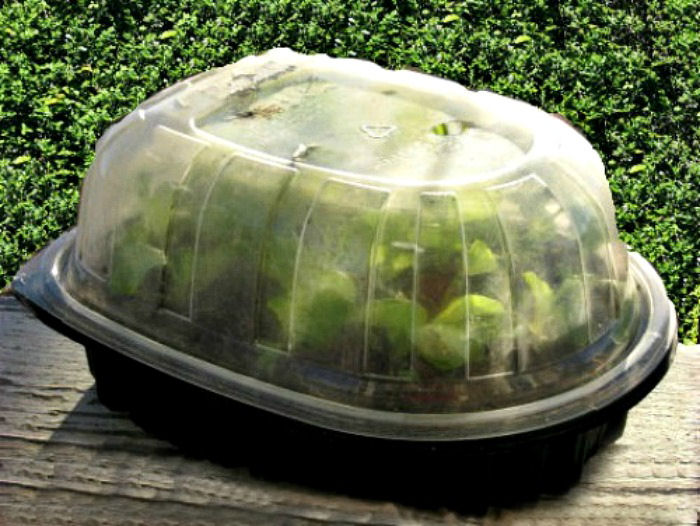 Rotisserie chicken containers make wonderful trays for seedlings that need moisture as they start to grow. Check out the DIY seed starting tray tutorial to find out more.
Rotisserie chicken containers make wonderful trays for seedlings that need moisture as they start to grow. Check out the DIY seed starting tray tutorial to find out more.
I love to use the container as a mini terrarium for succulents. It makes taking care of them a breeze and looks great, too!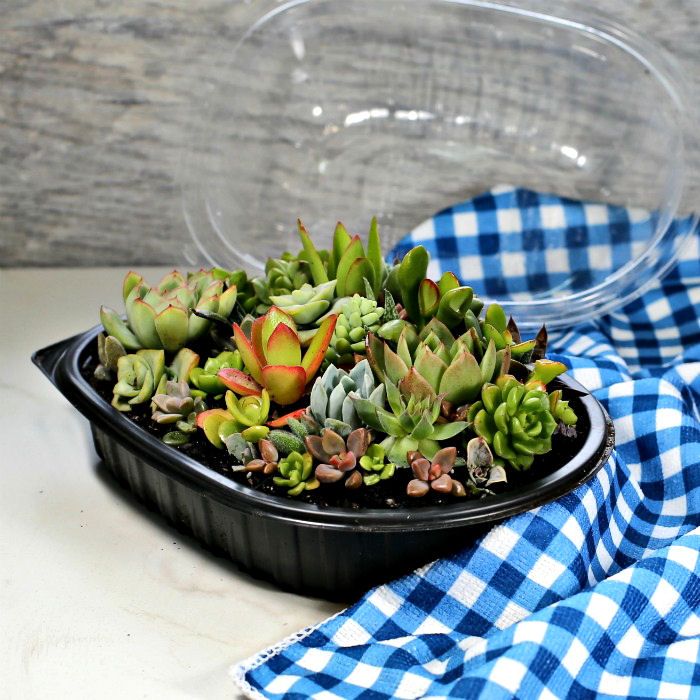
Weeding Vegetable Garden Hacks
Pulling weeds is the bane of any vegetable gardener. It seems that, some years, I can spend as much time weeding as I do harvesting vegetables!
Having some natural weed killers on hand to help keep this task to a minimum is a huge money saver for me. Here are two of my favorite natural weed killer formulas.
Vinegar Natural Weed Killer
Even though you may want to keep those weeds away, you don’t have to reach for the Round Up weed killer, especially when you’ll be using it near edible plants.
My natural weed killer formula uses organic vinegar as its main ingredient to keep those weeds away.

Spray this weed killer on your garden paths, and weeds will soon be a thing of the past. Just be careful not to spray it too close to your vegetables, or the vinegar will damage them, too.
Find out how to make this organic garden weed killer here.
DIY Weed Killer for Creeping Charlie
This particular weed killer is meant specifically for the weed Creeping Charlie, which is normally found in lawns. Since many vegetable gardens are surrounded by lawns, the weed can also find its way into your veggie garden.

The formula uses 20 Mule Team Borax to make a concentrated weed killer that you mix with water. Find out how to make the Borax weed killer here.
And if you have ants in your garden or home, be sure to check out my tests of 5 types of Borax ant killers to find out which one works the best.
Creative Vegetable Garden Hacks for Growing Tomatoes
If you love to grow tomatoes and other vegetables, you will know that there can be many vegetable garden problems and especially common tomato plant problems that plague you through the summer. Many of these hacks will be useful to help overcome them.
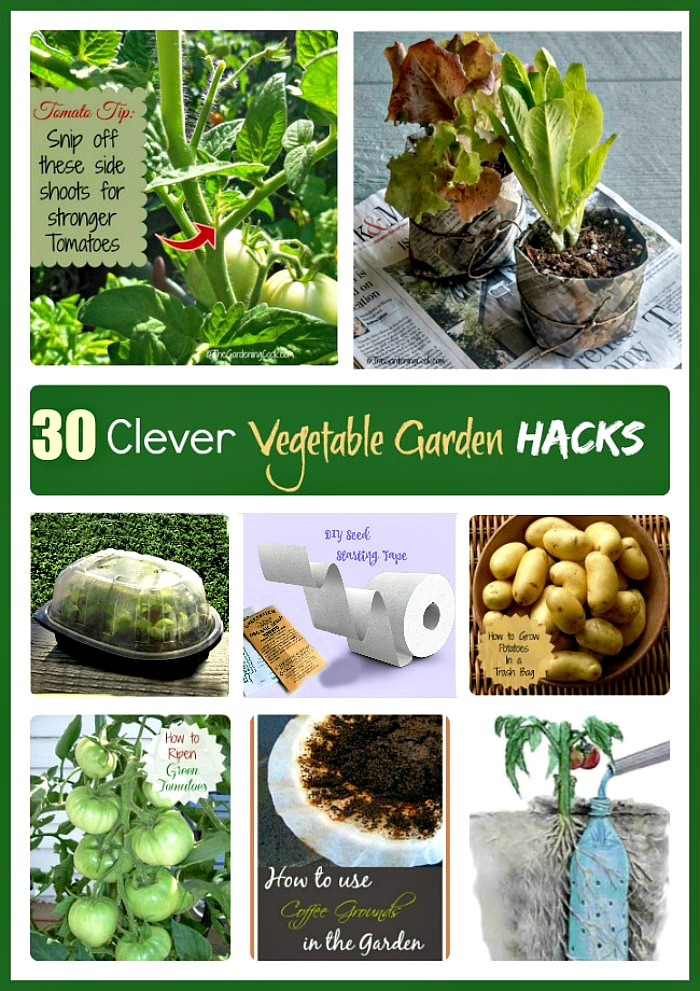
Some of these vegetable hacks are easy to do and others require a bit more work. They will all make lighter work of your garden chores.
Take Cuttings of Tomato Plants
Plant propagation is the process of using parts of existing plants to get new plants for free. Most of the time, when cuttings are mentioned as a means of propagation, it is done with indoor plants.
Succulents are also a common plant to propagate from stem and leaf cuttings. But did you know that you can take cuttings of tomato plants, too?

All you need is a sharp pair of scissors and an existing tomato plant.
The cutting can be placed in soil in plant pots (you can even use the newspaper pots described above to save more money!) In a few weeks, you’ll have a new tomato plant to add to your vegetable garden.
Find how how to grow tomato plants from cuttings here.
Will Baking Soda Sweeten Tomato Plants?
There is a lot of information on the internet. Some of it is true and some is quite misleading.
Everyone loves sweet garden tomatoes and we want to be able to grow them. There is some thought that you can make yours even sweeter with a sprinkling of baking soda near the plants.
But is this true?
I’ve written an article on the tips, tricks and myths for growing sweet tomatoes. Find out the answer here.
Snip off Those Side Shoots
Tomatoes are rampant growers in the vegetable garden. In fact, they grow so fast that they can get really top heavy.
To prevent this from happening, just pinch out the side shoots that grow at the leaf nodes.
This will make the stem more stable and also make it easier to fasten it to a stake. See how to do this and discover more tomato growing tips here.
Be careful with too much pruning of tomatoes, as this can lead to tomato plant leaf curling.
Soda Bottle Drip Feeder
This is one of my most popular DIY garden ideas on a budget! Readers seem to love this idea.
Watering tomato plants (and some other vegetable plants) from the root area is better for the plant because it lessens the chance of damage to the leaves and a calcium deficiency which leads to blossom end rot. Inconsistent watering can also lead to tomato blossom drop.
However, drip watering systems can be quite expensive.
This image from a Russian gardening blog that is no longer being published gave me the idea for a more budget-friendly drip feeder.
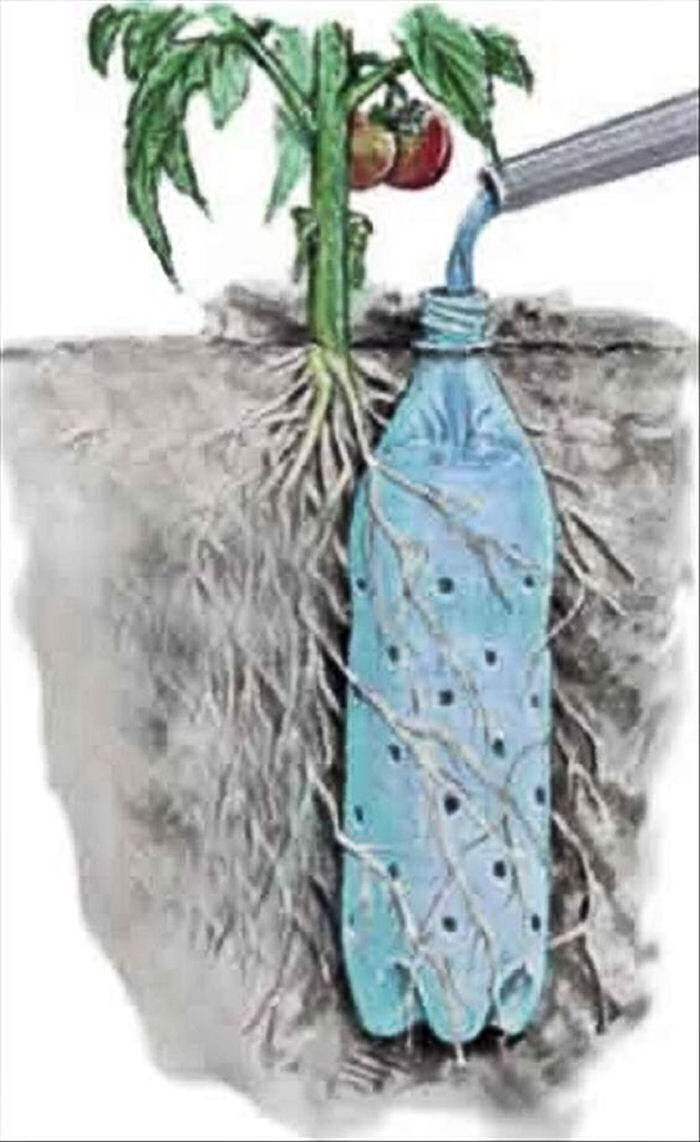
Make your own drip watering system for just pennies. Check out this DIY soda bottle drip feeder project to find out how to do it.
Tips for Ripening Green Tomatoes
I find that if I leave my tomatoes to ripen on the vine, the squirrels in my yard will have a feast just as they are ready to harvest.
This doesn’t need to be a problem, though. Tomatoes will ripen indoors and be just as sweet as those left on the vine until mature.

Also, when frost hits in the fall, it can mean that there will be a lot of tomatoes which would be damaged by the cold weather. Don’t waste those tomatoes. See my tips for ripening green tomatoes indoors.
Easy Garden Projects to Give Vegetables Support for Climbing.
Many vegetables, such as indeterminate tomatoes, and pole beans need support to hold them up or allow their vines to climb. These DIY gardening ideas will show you some life hacks for making this job easier and save you money, too.
Easy DIY Bean Teepee
My grandmothers heirloom pole beans have been in our family for many generations. This type of beans really loves to climb on supports.
This easy DIY bean teepee can be assembled in just minutes and the kids will love to sit under it when it is covered over with bean vines.

The DIY Bean Teepee is made from three recycled tomato stakes tied with pantyhose, and it gives great support to climbing beans.
DIY Plant Stakes
Some other vegetables get quite large and will need staking as they grow. Indeterminate tomato plants are one of these. You can purchase tomato cages for the plants, of course, but some of these are quite expensive.
A cheaper idea is to make your own DIY plant stakes. All you need is a recycled expandable curtain rod.

Just tie pantyhose to the curtain rod (this will protect the stem). As the plant grows, expand the curtain rod and keep tying the stem higher and higher to the support.
Support for Cucumber Vines – Garden Hacks that Work!
One of my favorite cucumber growing hacks is to let the vines grow up instead of along the ground. Doing this takes up less room and helps the cucumber plants from contracting soil born diseases.
Once, again, you don’t need fancy cucumber trellises.
We made ours by inserting some pieces of metal positioned around the cucumber plants and tying jute string in rows for the vines to attach themselves to.

The first year that I tried this, I had the best cucumber harvest ever and the cost was only a few dollars for jute string. Find out how to grow your cucumbers up instead of out.
Fun Vegetable Gardening Hacks
The kids will love these fun projects are easy to do but have a big impact.
Growing Potatoes in Trash Bags
There is nothing quite like the taste of home grown potatoes, but this crop takes a lot of room in a garden.
Or does it? Did you know that you can grow tomatoes in a small space by using large trash bags?
 One large bag can produce pounds of potatoes in a very small space. Growing them this way also reduces the amount of digging needed at harvest time.
One large bag can produce pounds of potatoes in a very small space. Growing them this way also reduces the amount of digging needed at harvest time.
Find out how to grow potatoes in a large trash bag.
Cut and Come Again Vegetables
One of my favorite things to do with kids to introduce them to gardening is to demonstrate how to use parts of vegetables to grow new plants.

You will be amazed at just how easy this vegetable hack is and how many vegetables will re-grow using this technique.
Find out all about how to grow cut and come again vegetables.
Vegetable Garden Tips and Tricks for Critters
If you have a vegetable garden, you will have critters. They enjoy the food as much as we do!
Squirrels are a major source of irritation to me, so finding ways to deal with them is at the top of my list of best gardening hacks. Read on to find out how I try to keep these guys away from my harvest.
Keep Squirrels out of the Garden Naturally with These DIY Gardening Ideas
From using red pepper flakes and peppermint oil, to installing motion detectors and making garlic sprays, I have tried a number of natural squirrel repellent ideas.

Do you have a problem with squirrels? If so, these natural squirrel repellent ideas may prove useful to you.
DIY Squirrel Repellents
The squirrels did a number of my garden one year, and I decided to get serious with them.
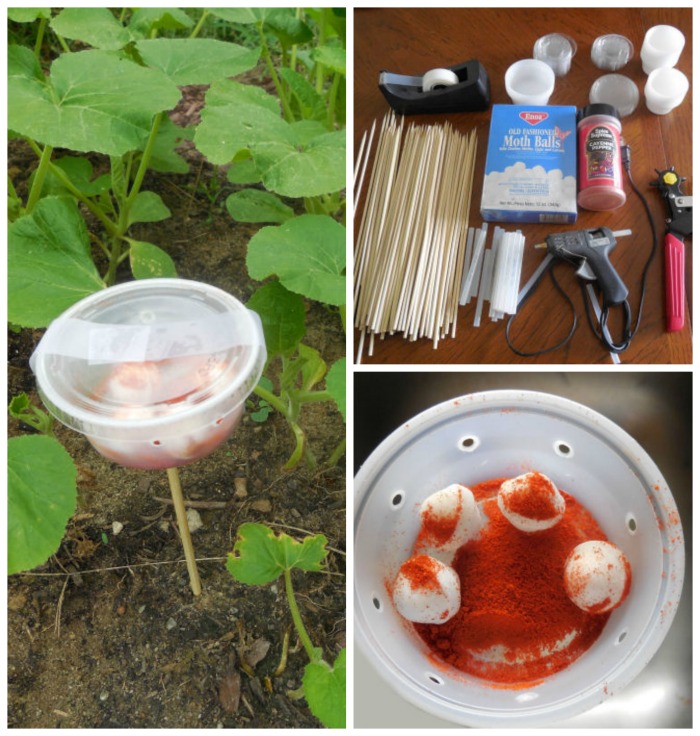
NOTE: These DIY Squirrel Repellents were easy to make and did a pretty good job. One concern I had with these repellents was that they used moth balls, which can be harmful to pets. If you decide to use them, take care, and read my comments concerning their use in the article.
Keeping squirrels from digging up flower bulbs
It is not just vegetables that squirrels love to eat. They are notorious for digging up and eating flower bulbs too.
Nothing is worse that planting bulbs in the fall, only to have them all eaten by squirrels. Fortunately, there are some ways to prevent this.
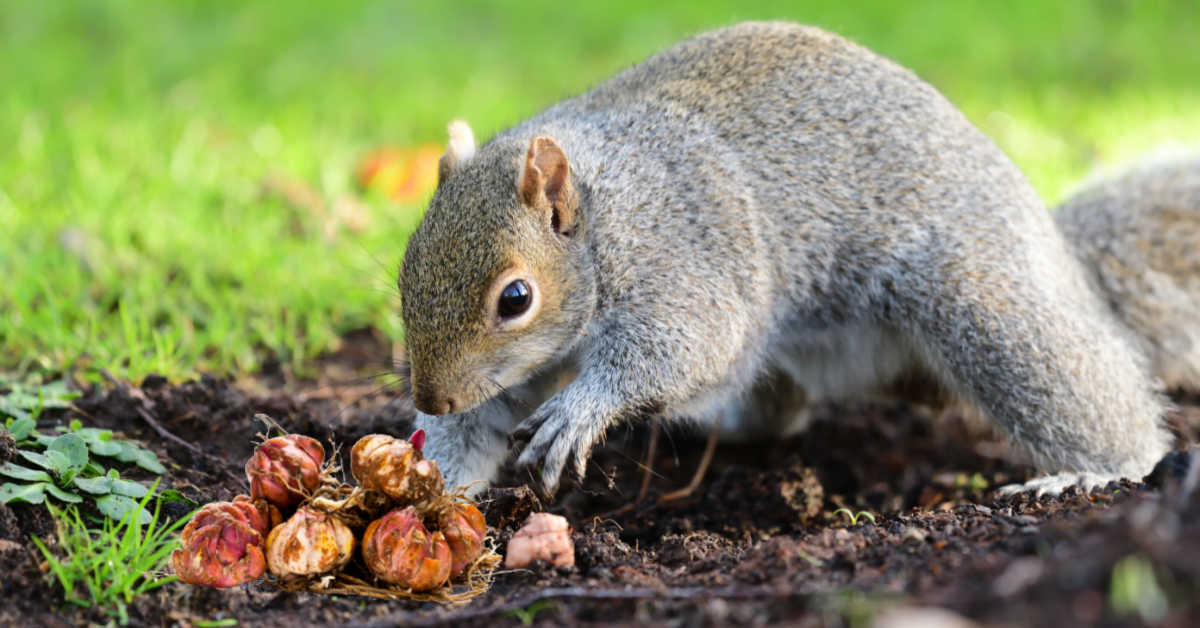
Check out my post for how to keep squirrels from digging up bulbs.
Easy DIY Garden Ideas for Tending a Garden
Once you have the garden planted and have managed to keep the critters away, it’s time to take care of those plants. Vegetable gardens need fertilizing, hoses need to be managed and it’s nice to attract hummingbirds to your yard.
All of these things can be accomplished cheaply and quickly with these tutorials:
Easy Raised Garden Bed
Raised garden beds are easy on the back, and you can grow vegetables much more closely in them. This gives you extra harvest in less space.
They are also very easy to make. You can used recycled materials to make a cement blocks raised garden very inexpensively.
If you want flexibility and beauty as well as a quick design, check out my easy raised garden bed project. We made two raised beds in just a few hours!

Make Your Own Miracle-Gro Plant Food
Most vegetable plants need some sort of fertilization to grow to their optimum. Adding compost is one way of doing this, (see some tips below) but having a plant food on hand is also a good idea to consider.
 Miracle-Gro is a commercial plant food often used by many gardeners.
Miracle-Gro is a commercial plant food often used by many gardeners.
With just a few ingredients, you can make your own plant food at a fraction or the cost. To find out more, check out this post for making homemade Miracle-Gro and four other other plant foods.
DIY Hose Guides – Stop Trampling Those Veggies!
Unless you have a permanent watering system for your vegetable garden, you will find that you are dragging a hose through the veggie patch to get water to the plants.
This can do quite a bit of damage to low growing vegetable plants.
These DIY hose guides are made out of short pieces of rebar with small plastic orange golf balls on top. They keep my hose out of the garden and add a decorative look to the garden at the same time.
They are very inexpensive to make and take no time to assemble.
Make Your Own Hummingbird Nectar
If you combine your vegetable garden with companion flower plants, you may be rewarded by the sight of hummingbirds paying you a visit.
 There is no need to buy their food at retail prices. Hummingbird nectar is very easy and inexpensive to make. It also keeps very well in the fridge.
There is no need to buy their food at retail prices. Hummingbird nectar is very easy and inexpensive to make. It also keeps very well in the fridge.
Composting DIY and Inexpensive Mulching Ideas for Vegetable Gardens
If you are interested in backyard garden ideas on a budget, composting is something to experiment with. Turning garden refuse and kitchen scraps into fertilizer for gardens is one of the most cost saving garden projects out there.
There are lots of ways to compost and you don’t need a typical compost pile to take advantage of the opportunities that compost can give you.
On the Spot Composting DIY
Do you like the idea of adding compost to your garden, but don’t have space for a compost pile? On the spot composting is the way to go!

Fill your old fast food bags with kitchen scraps and bury them near your plants. The refuse will break down along with the paper bag, and both will add nutrients to the soil. A big plus for some is that you won’t have an unsightly compost pile in your yard!
Find out how to do on the spot composting in this post.
Making your own mulch from fall leaves
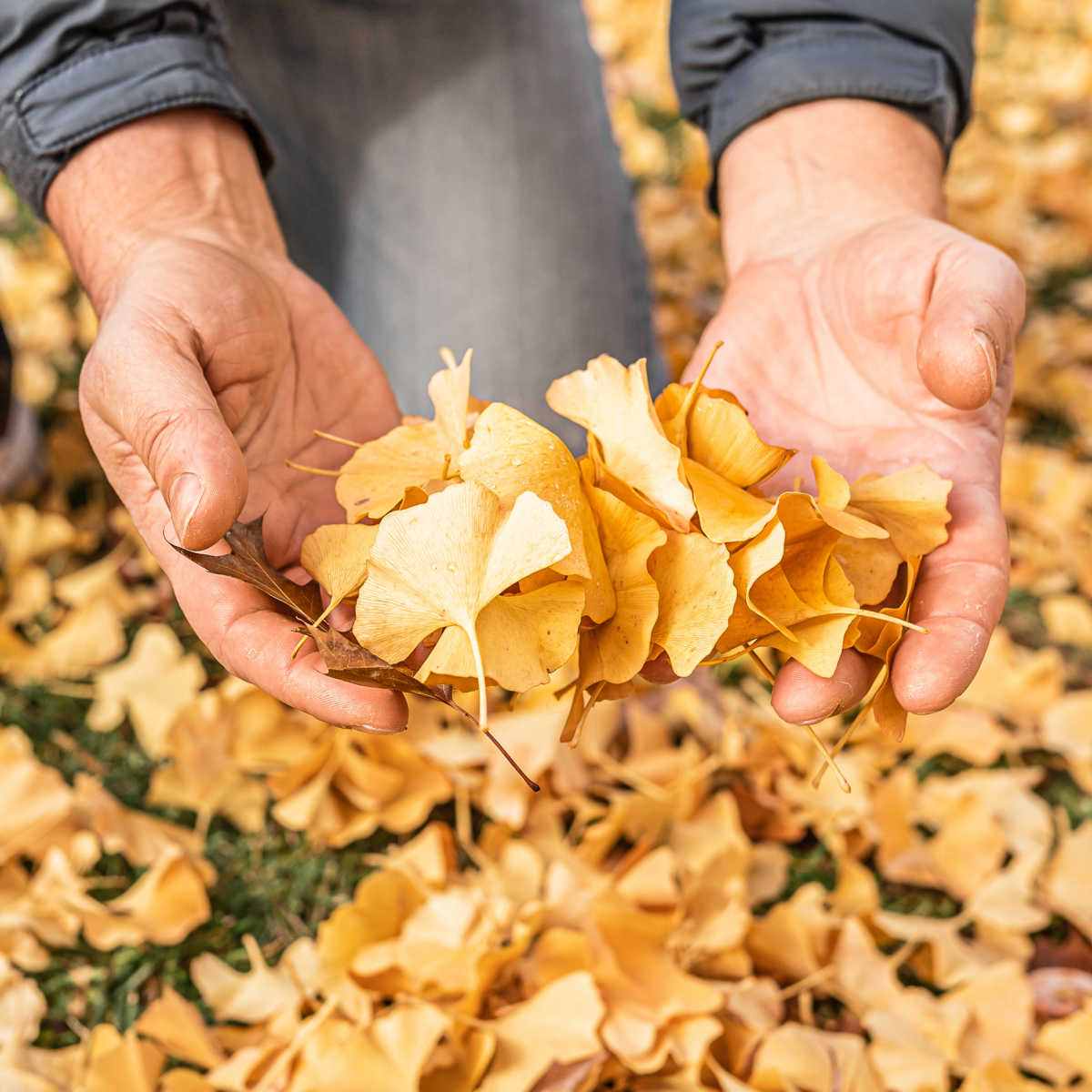
Leaves are abundant in the fall. Don’t throw them away – use them to make your own composted leaf mulch.
Read all about them and learn how to make leaf mulch here.
How to Use Coffee Grounds for Vegetables
Adding coffee grounds around your vegetable plants will add copper, magnesium, potassium and phosphorus to them. They also slowly release nitrogen to the plants over a long time period.
 Try adding your used coffee grounds to the soil near your vegetables and see how well they grow.
Try adding your used coffee grounds to the soil near your vegetables and see how well they grow.
If you enjoy flower gardening, camellias, hydrangeas and roses love the grounds because they add acid to the soil.
Junk Mail Mulch
We get a lot of junk mail every day at our house and normally just recycle it. Instead, put it to use in the garden as mulch.

All you need is a paper shredder and some water and you can turn unwanted mail into garden mulch.
Newspaper Mulch
Another idea for recycling paper is to use old newspapers to make mulch.
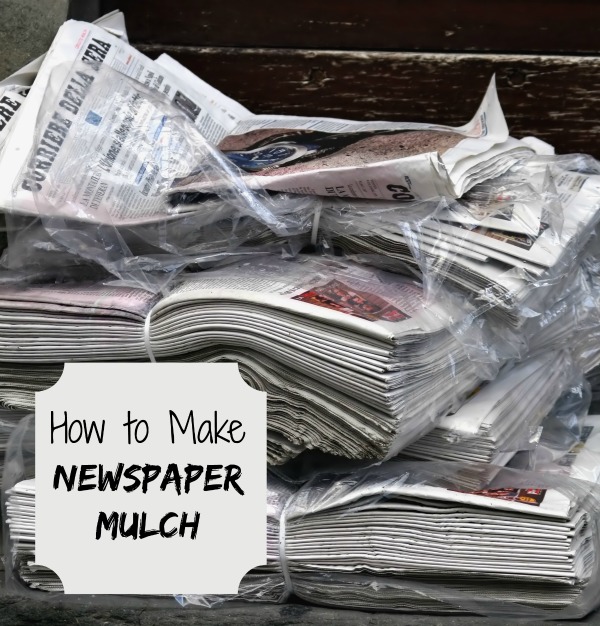
Newspaper is a great product to use to control the weeds in your garden. It is beneficial in both flower and vegetable gardens. The newspaper adds a barrier that keeps weeds from growing.
Newspapers retain moisture in the soil and also add organic material as they break down. The worms just love them! Making newspaper mulch is simple and so beneficial
Recycled Compost Screens
My local garden center gives me long plant trays when I buy a large amount of vegetable seedlings. I used to add them to the recycle bin, but then it occurred to me that they would make great compost screens.

If you have tried composting, you will know that not all of the materials break down at the same time. Sifting is necessary to get a good consistency of the humus that forms.
Instead of buying an expensive compost sifter, I made my own DIY Compost Screen by using these common plastic garden trays in a creative way.
Inexpensive Ways to Turn a Compost Pile
A compost pile needs to be turned regularly to increase the decomposition of the materials in it and also to solve many other compost pile problems.
A garden fork or special compost turning tool is normally used for rotating the materials in a compost pile.
But these tools are not the only ones that will do this job. There are loads of items found around the home that can be used to aerate the compost pile.

Check out these inexpensive ideas for turning a compost pile using things you might not have considered.
Trench Composting Life Hack
For those that don’t want the hassle and work of an actual compost pile, trench composting is an alternative.

For trench composting, you dig a trench about 12 inches deep and than add in 4 to 6 inches of materials that will decompose in it.
Once the trench has the materials in it, you cover the hole with soil and the matter breaks down over a few weeks time.
Find out more about trench composting here.
Rolling Compost Pile
We’ve all seen images of elaborate bins to hold compost. These require a lot of work to transfer the material from one bin to the next so that it will break down.

Instead of composting this way, I use a rolling compost pile.
For this method of making compost, the pile is just turned and moved across the garden and it breaks down very quickly. This is one of my favorite ways to make compost.
Small Backyard Landscape Ideas on a Budget
A vegetable garden can take a lot of room in your yard. If your yard is small, you can still grow vegetables successfully. It just means thinking outside the box.
Vegetable Garden on a Deck
If you have a back deck or patio, you have the potential for a good sized harvest of vegetables this year. Just use containers!

Last year, instead of growing my vegetables in a large garden plot, I planted everything on a deck garden. It made my summer gardening chores SO much easier and still gave me a nice variety of vegetables to enjoy.
Concrete Blocks Raised Garden Bed
Recycling used items is one of my favorite DIY garden projects. Concrete blocks were this year’s make over material.
I used them to make two raised garden beds for my vegetable garden. The project was easy to do and inexpensive, compared to the cost of normal raised garden beds.
The blocks were sealed to make them safe and the elevated planters blend into my garden in a very cohesive way.
See how I made this raised bed vegetable garden.
I hope that you have enjoyed this collection of inexpensive DIY garden projects. Try a few of them to see if they will give you the beautiful vegetable garden that you have been craving – all within budget!
Now it’s your turn to share your DIY garden ideas on a budget.
What other vegetable growing hacks have you used to make your gardening chores easier? Please leave your suggestions below to share with other readers. I will add some of my favorites to this post with a shout out to you
Pin These DIY Garden Ideas on a Budget for Later
Would you like a reminder of these inexpensive vegetable garden hacks? Just pin this image to one of your gardening boards on Pinterest so that you can easily find it later.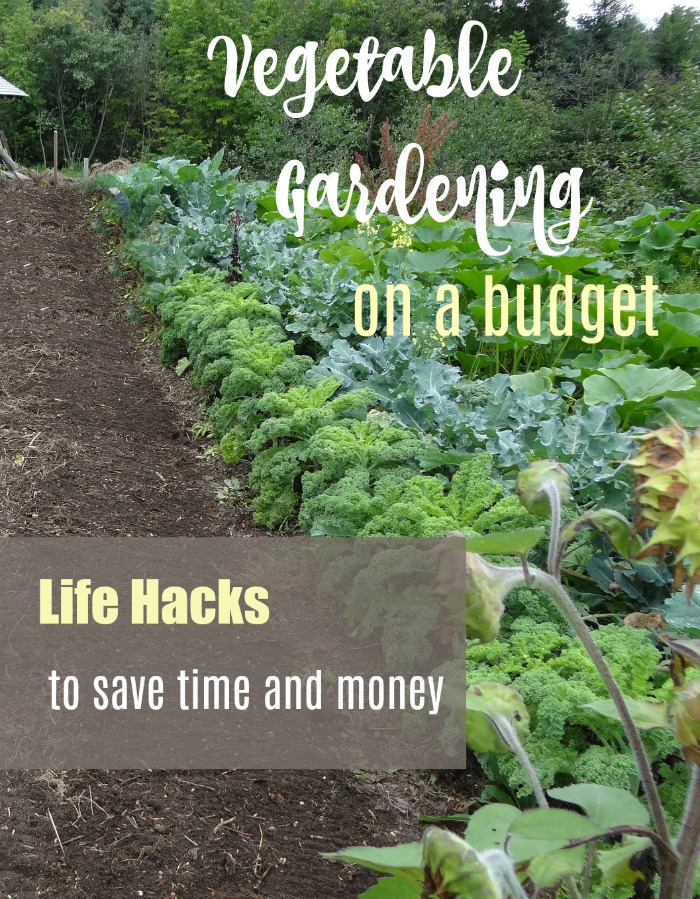
Admin note: This post first appeared on the blog in July of 2016. I have added more DIY garden ideas on a budget, new photos, a printable for your garden journal and a video for you to enjoy.
Printable for DIY Garden Ideas on a Budget
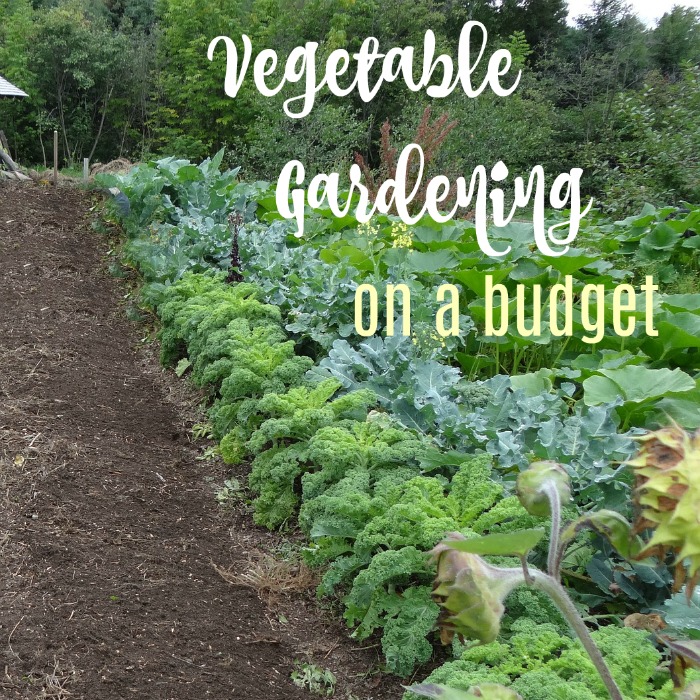
Print out the graphic below and place it in your garden journal to remind yourself of these DIY Garden Ideas on a Budget.
Materials
- Card stock paper or glossy photo paper.
Tools
- Deskjet printer
Instructions
- Print out the graphic below and add it to your gardening journal as a reminder of these projects.
- When you would like the instructions, just search the site for the project.

Recommended Products
As an Amazon Associate and member of other affiliate programs, I earn from qualifying purchases.




Rushin Shah
Thursday 27th of June 2019
some really nice tips, i am really curious to use baking soda with tomatoes, i am going to plant new tomatoes next week, i ll definitely try and let you know how it went.
Agatton
Sunday 23rd of September 2018
Great tips I really like #2 and need to remember that, would be perfect for hanging planters to reduce weight. Number nine is another neat one because I do a lot of propagating. Was just rounding up all those plants this weekend for the move. I’m wondering if this speeds up the process? Normally I take cuttings in the fall and then wait to see what happens over winter and I’m normally pleasantly surprised by spring. I’m going to give this a try at some point. Could be an awesome project.
Al Renschler
Thursday 12th of April 2018
I have found that some fast food places like chik fil get buckets of pickles. If possible get buckets for free cut the bottom out and use for cabbage or other cold season plants this provides warmth and wind protection for seedlings. This alow planting earlier. My Bucket garden is out now.
Carol
Thursday 12th of April 2018
Carol
Thursday 12th of April 2018
That is a great idea Al. Thanks for sharing it. Carol
Pinson
Sunday 1st of April 2018
Lawnrick lewis you are right. I usually watch and found lots of hacks. But gardening hacks I found 1st time. I read this post several times. It's really inspired me. So you deserve a thank you from my site, "Carol"
Lawnrick lewis
Thursday 8th of February 2018
If this could be classified as a garden hack ,well for me it is.I always forgot to get the pH kit from the store .So to test the level of acidity /alkalinity ,I always use vinegar or baking soda .if the soil fizzes in vinegar then it's alkaline ,with a pH of 7-8 .if it doesn't fiz ,add some distilled water and then add baking soda .If it fizzes upon adding the baking soda ,the soil is acidic (ph5-6). If the soil doesn't fiz in both cases ,the soil is neutral . This has always worked for me .I hope it works for you as well .
I'll be trying some of the tips you just listed for us .Most of them are very new to me .